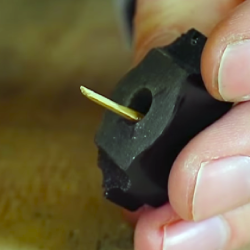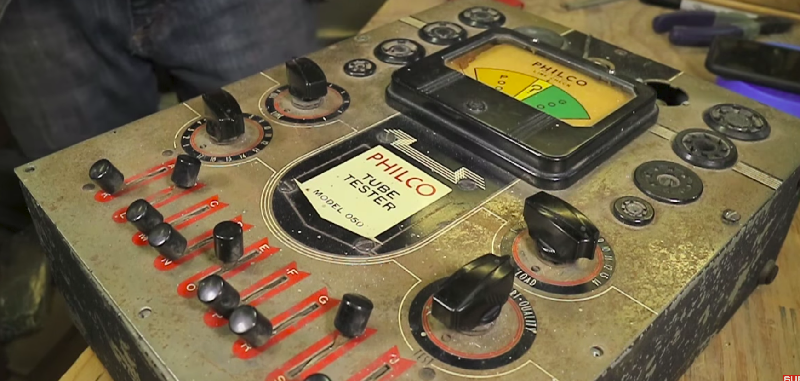Knobs! Shiny candy-colored knobs! The last stand of skeuomorphism is smart light switches! Everyone loves knobs, but when you’re dealing with vintage equipment with a missing knob, the odds of replacing it are slim to none. That’s what happened to [Wesley Treat] when he picked up a vintage Philco tube tester. The tester looked great, but a single knob for a rotary switch was missing. What to do? Clone some knobs! You only need some resin and a little bit of silicone.
 The process of copying little bits of plastic or bakelite is fairly standard and well-tread territory. Go to Michaels or Hobby Lobby, grab some silicone and resin, make a box, put your parts down, cover them in silicone, remove the parts, then put resin in. For simple parts, and parts with flat bottoms like knobs, this works great. However, there’s something weird about the knob on this old Philco tube tester. Firstly, it doesn’t fit a standard 1/4″ shaft — it’s a bit bigger. There’s also no set screw. Instead, this knob has a stamped spring aligning it with the flat part of the D-shaft in this rotary switch. This means a copy of this knob wouldn’t be useful to anyone else, and that no other knob would work with this tube tester.
The process of copying little bits of plastic or bakelite is fairly standard and well-tread territory. Go to Michaels or Hobby Lobby, grab some silicone and resin, make a box, put your parts down, cover them in silicone, remove the parts, then put resin in. For simple parts, and parts with flat bottoms like knobs, this works great. However, there’s something weird about the knob on this old Philco tube tester. Firstly, it doesn’t fit a standard 1/4″ shaft — it’s a bit bigger. There’s also no set screw. Instead, this knob has a stamped spring aligning it with the flat part of the D-shaft in this rotary switch. This means a copy of this knob wouldn’t be useful to anyone else, and that no other knob would work with this tube tester.
However, a bit of clever engineering would make a copy of this knob fit the existing switch. Once the resin was cured, [Wesley] drilled out the hole, then sanded a dowel down to fit into the flat of the D-shaft. It took a little kergiggering, but the knob eventually fit onto one of the rotary switches. Not bad for a few bucks in silicone and resin.
You can check out the entire build process below.

















I love love love Wesley Treats. One of my favorite Makers on YouTube. So happy to see this on here. You gotta check out his channel.
yea ok he used products as intended, posted a video about it, and begged for money at the end… awesome
hmmmm… isn’t that the case for a lot of projects? At least he made/fixed something, while others are only mumbling about some old hardware, or criticizing the works of others (they call it a review).
Difficult parts to obtain is the main reason for starting a replication business.
https://www.vandykes.com/
for antique replacement glass, knobs, latches, hinges…
I so need a tester… I love restorations!
Great Job! Thanks for the post.
Ah just run over to RadioSh…oh ya. Um. Amzon. Good job on the repro. On hack scale is like meh to 101. If part was scanned in for other would be ‘Preservation Artist’ and showing methods , mod with mcu/o’scope to do matching on curves and automate setup for testing, went through various patch cables and period mods that expanded its testing capabilities, how to cut a neg-D, or stuff like that then would be interesting hack. Didnt even mention mold dimensional loss or how to prevent warp.
Wasn’t ‘psyched’ at all fwiw. Shoot in lower res , add haze filter, zoom out more, dirty /scratch up knob, for that. Attempt at misdirection sad. Wood and cyanoacrylic on resin cast in cylinder to prevent slip. Good not intended for use.
Modern RTV silicones and resins don’t shrink, or if they do it’s fractions of a thousandth of an inch.
Mmmm k. Mold itself ok can agree usually ~.002 at given temperature by different manufacturer but varies . cheaper and older stuff can get much farther off . Smooth-on claims .001″ and will have to test that myself eventually. Onyx tm Resin- .012 in/in is a fraction of .001? Anyway wasn’t discussed/narrated. Not that’s all important consuming factor for this project but bears mentioning which products chose and why along with loss of detail possible. Fairly strong resin worthy of more investigation from my POV but wouldnt have gathered from vid.
It’s a good primer, warts and all for getting started in just how easy it is to make some simple quick replacements.
Could he have done a better job? possibly.
Could he have sealed the edges of the knobs to stop the silicone flowing under, made a two part to save drilling and sanding, aligned it perfectly, degassed and so on. Sure.
But he knocked off a quick part which is 99% good enough for restoring something in poor to medium condition which was heading for a dumpster.
Right tools for the right job. Perfection isn’t always the goal.
It’s not a channel about making perfect molds !!
If you talked to one of the main antique radio knob dealers (I happen to be one of about 5 pros who sell knobs as a specialty) you would have found that the knobs on the Philco tester were also used as “band switch” knobs on their 1936 era radios. While they are not super common, they are not rare either. I think I have maybe 6 in stock now. See models 635 , 680, some of the model 116 radios had them too. The knob shaft is the common ,250 dia however it is flatted only slightly, this was the stock cut for Philco up thru the 1941 model year, then they switched to the half flatted to match the rest of the radio industry. Sears silvertone was the same as Philco, and some others did it but mostly to give set screw knobs a spot to set against. So, before you resort to making knobs, always check with us knob dealers. We are not on Ebay, we are at most of the larger antique radio shows east of the Mississippi, like the Vintage Electronics Expos in Michigan, or the Kutztown PA radio events in May and Sept, or Charlotte, NC event Mar 22-23, etc. Also there is a major knob maker who has many knobs already made to sell, http://www.renovatedradios.com . hope this helps Mark http://www.oldradioparts.net